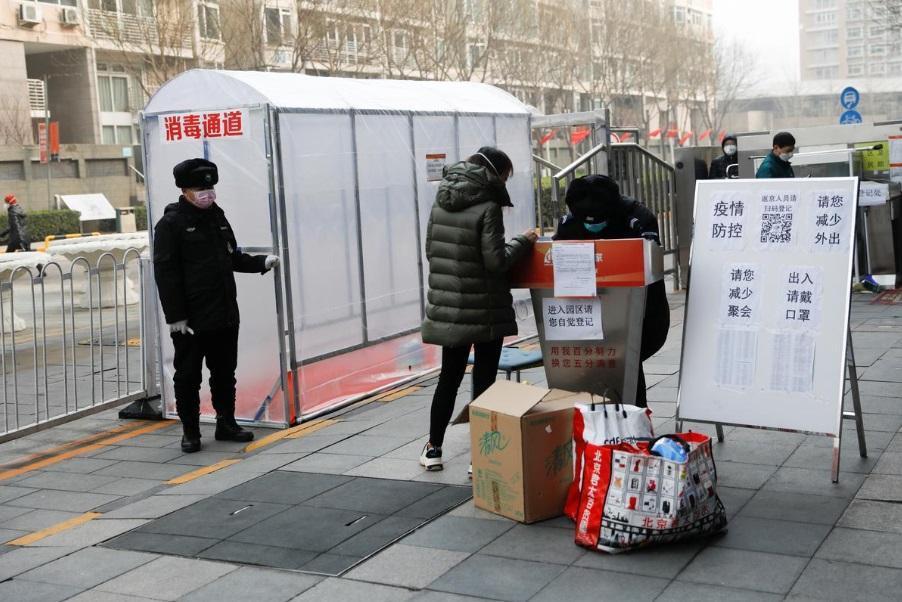
A security guard stands outside a plastic tent set up to disinfect people coming in at the entrance of a residential compound, as the country is hit by an outbreak of the new coronavirus, in Beijing, China, on Feb. 13, 2020. (REUTERS Photo)
The Chinese province at the epicenter of the coronavirus outbreak reported a record rise in the death toll on Feb. 13 under a new diagnostic method, and Beijing sacked two top provincial officials after criticism of their handling of the crisis.
Health officials in Hubei province said 242 people had died from the flu-like virus on Feb. 12, the fastest rise in the daily count since the pathogen was identified in December, and taking the total number of deaths to more than 1,350. A total of 1,310 deaths have been reported from Hubei.
Asian stock markets wobbled and the safe-havens of the Japanese yen, gold and bonds rose after the new Hubei numbers dashed hopes the epidemic was stabilizing and the Chinese economy could bounce back quickly.
The spike in the death toll came a day after markets were cheered when China reported its lowest number of new cases in two weeks, bolstering a forecast by the country’s senior medical adviser that the epidemic could end by April.
Reports in state-run media said provincial Communist Party boss Jiang Chaoliang had been sacked as secretary of the Hubei Provincial Committee, and Ma Guoqiang had been removed as party chief in the provincial capital Wuhan.
The reports did not give a reason for the dismissals but the two are the most high-profile Chinese officials to be removed from duty following the coronavirus outbreak that began in Wuhan late last year.
“Thank you Communist Party. It should have been done earlier,” Wuhan resident Wang You told Reuters.
Dozens of low-level health officials across the country have also lost their jobs for failing to contain the epidemic, which is believed to have emerged from a market in Wuhan where wildlife was traded illegally.
Another 14,840 cases were reported in Hubei alone on Feb. 13, from 2,015 new cases nationwide a day earlier, after provincial officials started using computerized tomography (CT) scans to look for signs of the virus.
About 60,000 people have now been confirmed to have the virus, the vast majority in China.
Hubei had previously only allowed infections to be confirmed by RNA tests, which can take days to process. RNA, or ribonucleic acid, carries genetic information allowing for identification of organisms like viruses.
Using quicker CT scans that reveal lung infections would help patients get treatment more quickly and improve chances of recovery, the Hubei health commission said.
The new diagnostic procedure could explain the spike in deaths, according to Raina McIntyre, head of biosecurity research at the Kirby Institute at the University of New South Wales.
“Presumably, there are deaths which occurred in people who did not have a lab diagnosis but did have a CT. It is important that these also be counted,” she told Reuters.
The new testing methodology is only being used in Hubei province, Chinese officials said.
The World Health Organization (WHO) said on Feb. 12 the number of cases of infection in China had stabilized but it was too early to say the epidemic was slowing.
“This outbreak could still go in any direction,” WHO chief Tedros Adhanom Ghebreyesus told a briefing in Geneva.
Chinese scientists are testing two antiviral drugs and preliminary clinical trial results are weeks away but a vaccine could take 18 months to develop.
Hundreds of infections have been reported in more than two dozen other countries and territories, but only two people have died from the virus outside mainland China - one in Hong Kong and one in the Philippines.
The biggest cluster of cases outside China is on a cruise ship quarantined off the Japanese port of Yokohama, where a further 44 cases were reported on Feb. 13. In all, 219 of about 3,700 people on board have tested positive.
There was a happy ending for another cruise ship, the MS Westerdam, which docked in Cambodia after being denied docking rights in Thailand, Japan, Taiwan, Guam and the Philippines over fears one of its 1,455 passengers and 802 crew might have the virus, even though none had tested positive.
“Just seeing land was such a breathtaking moment,” Angela Jones, an American tourist on the ship, told Reuters. “I thought: Is this real?”
Wuhan, a city of 11 million people, remains under virtual lockdown, and other major Chinese cities are facing severe travel restrictions.
Many airlines have suspended flights to China, while countries have imposed bans or quarantine for people arriving from China, disrupting businesses and playing havoc with conferences and sporting events.
The Mobile World Congress, a telecoms industry gathering that draws more than 100,000 visitors to Barcelona, has been canceled after an exodus of exhibitors.
The Formula 1 Chinese Grand Prix, set for Shanghai on April 19, was postponed, as was Singapore’s rugby sevens tournament scheduled for April 11-12, a source said.
Hong Kong, where 50 cases have been confirmed, extended the suspension of schools to March 16.